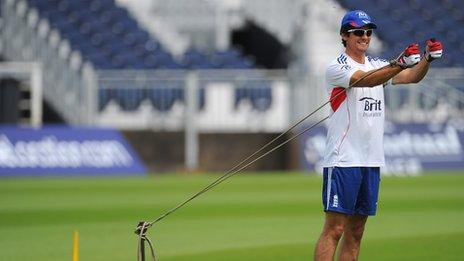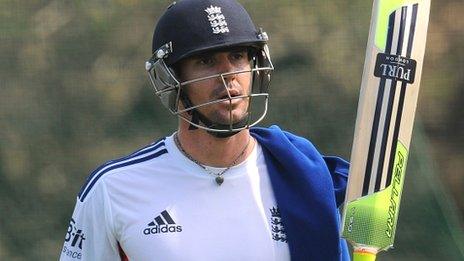DRS: Hot Spot should be removed, says Michael Vaughan
- Published
- comments

Hot Spot should be removed from the decision review system (DRS), says former England captain Michael Vaughan.
The infrared system has been part of DRS since 2009, but has drawn criticism in the Ashes series for failing to detect when a batsman edges the ball.
Inventor Warren Brennan wants the use of tape on bats to be banned, and said a protective coating "definitely diminishes Hot Spot marks".
But Vaughan said: "He's admitted his system will not work. It has to go."
And Alec Stewart, another former England captain, said Brennan's suggestion was "laughable".
There are currently no laws banning the use of tape and the International Cricket Council (ICC) said there was "no intention" of any imminent changes.
ICC general manager Geoff Allardice, who met both Ashes teams in the build-up to the fourth Test in Durham this week to discuss concerns over DRS, said: "We listened to Warren's view and there may be something in it but I'd think we'd want to gain a lot more evidence before we'd look at rule changes or anything like that.
"This was a theory that he put up on Monday this week. He did some tests that he felt supported that theory. We would like to see some more evidence from on the ground with players in action to support that."
Hot Spot was devised in 2007 by BBG Sports and works using heat sensors and infrared cameras to determine what the ball has made contact with.
Earlier this week reports from Australian broadcaster Channel Nine, external suggested players from both England and Australia had used tape to prevent edges showing on Hot Spot.
Kevin Pietersen was the only player named in the report, and the England batsman vehemently denied the allegation.
In a statement issued in response to criticism of edges being missed, Brennan said: "More than anyone else, BBG Sports wanted to know why. Following the Manchester Test match we analysed contentious Hot Spot decisions from the Ashes series and decided to purchase several of the latest generation of cricket bats to undertake thorough testing.
"The majority of bats had some form of protective coating that would wrap around onto the edges of the bat. Strangely enough, this protective coating would cover only half of the edge of the bat and not the entire edge. We believed this could cause the front edge of the bat to have a different thermal signature than the back edge of the bat.
"The type and thickness of the protective coating unquestionably affects the thermal signature of the Hot Spot system. In layman's terms, the protective coating definitely diminishes Hot Spot marks.
"In order to achieve optimum Hot Spot results then the removal of protective coating from bats edges needs to occur. This will allow for the best thermal signatures between cricket balls and natural timber cricket bats."
Vaughan told the BBC's Test Match Special: "The game of cricket isn't here to protect his business. We just want technology that will present the right result more often than not.
"In this series, Hot Spot hasn't produced the right result and to suggest that players take the protective covering off their bats is utter nonsense.
"It's not down to the game of cricket to try to help Hot Spot, it's down to Hot Spot to help the game of cricket. He clearly knows that his piece of technology isn't good enough so he's trying to devise a way that the game can help his technology and his business.
"Hot Spot clearly doesn't work with the tape on top and for that reason I don't think it can carry on."
Stewart added: "It's an embarrassing statement, just ridiculous. If you're going to produce something like Hot Spot, you've got to make sure you've done all the testing before you take it to the ICC to be used for international cricket.
"I played in the 80s, 90s, early 2000s and bat tape and coatings that go on bats have been around for 30 or 40 years so for him to suggest you shouldn't have a coating or a cover or any tape on your bat is laughable and I'd be embarrassed if I was associated with that company's statement."
- Published9 August 2013

- Published8 August 2013

- Published26 August 2013

- Published8 August 2013

- Published10 March 2019

- Published18 October 2019
